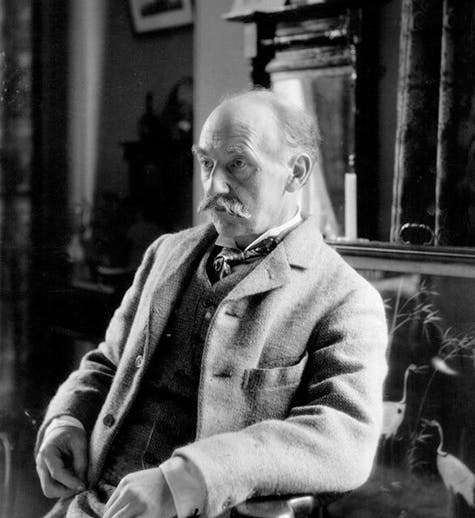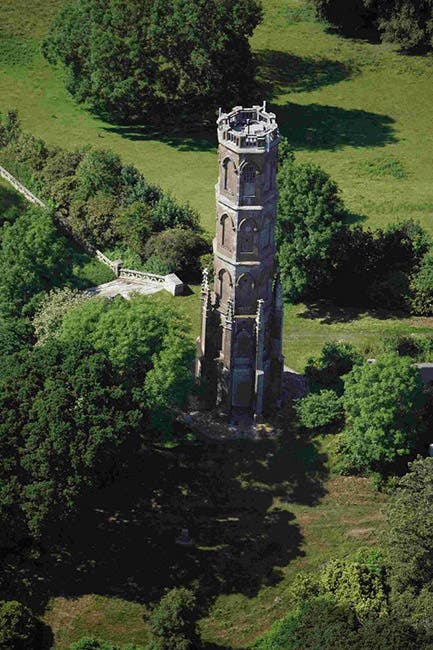Scientist of the Day - Thomas Hardy
Thomas Hardy, an English novelist and poet, was born June 2, 1840. Hardy is best known for such novels as The Return of the Native (1878) and Tess of the d’Urbervilles (1891), works that have little to do with science, but he did publish one novel with an astronomical connection, called Two on a Tower: A Romance (1882). One of the protagonists, Swithin St. Cleeve, is a young astronomer, who has set up his primitive telescope atop an unused folly tower on a country estate in Dorset (which Hardy calls Wessex), in order to do something famous in astronomy. There he is discovered by the owner of the tower and the estate, Lady Viviette Constantine, nine years older than young Swithin, whose husband has left her to spend two years shooting up the animal kingdom in Africa. Swithin endeavors to teach the Lady about the universe, and she proceeds to teach Swithin something about the human heart.
There is quite a bit of astronomy in the book, which is not the case with the many Victorian novels that pay token attention to science. Swithin is studying variable stars, and he needs a better telescope, an equatorial refractor, which Lady Constantine supplies him, and which he erects on the top of the tower, complete with rotating dome. He uses it to make a major discovery about variable stars (Hardy is non-specific here – apparently he did not know enough about variable stars to come up with a plausible new idea), only to find that he has been anticipated by a Canadian astronomer.
Throughout the first part of the novel, there is much discussion of the grandeur of the universe, which appears to be the reason why Hardy chose astronomy for Swithin's pursuit, to show how trivial human problems are when compared to the vastness of the cosmos. There is a point early on (chapter 4), where Swithin asks Lady Constantine how many stars she thinks she can see:
She looked around over the magnificent stretch of sky that their high position unfolded. ‘Oh, thousands, hundreds of thousands,’ she said absently.
‘No. There are only about three thousand. Now, how many do you think are brought within sight by the help of a powerful telescope?’
‘I won’t guess.’
‘Twenty millions. So that, whatever the stars were made for, they were not made to please our eyes. It is just the same in everything; nothing is made for man.’
Lady Constantine comments:
‘Is it that notion which makes you so sad for your age?’ she asked, with almost maternal solicitude. ‘I think astronomy is a bad study for you. It makes you feel human insignificance too plainly.'
There is another point in the novel when Swithin lies near death, from being out in the cold and wet, and he revives when he hears that a new comet has appeared in the heavens. In fact, there was a new comet in the night sky in June of 1881, when Hardy was writing his book, and Hardy observed it. It was not as grand as the comet of 1882, which became more famous, but it was grand enough for Étienne Trouvelot to include a lithograph of it in his portfolio of astronomical drawings, published the next year, which we include here (third image, below). The lithograph was probably more spectacular than the actual comet. But it did please Lady Constantine when Swithin showed her the comet with the equatorial on the tower. Anyway, something pleased her.
Since our overall theme is science and literature, and not just astronomy and literature, I thought I would mention one other passage where Hardy shows off his scientific chops. In chapter 16, Swithin has run off to help his grandmother, whose chimney has fallen down and wrecked her house, leaving his would-be lover behind on the tower. Hardy continues:
Under any other circumstances Lady Constantine might have felt a nameless fear in thus sitting aloft on a lonely column, with a forest groaning under her feet, and palęolithic dead men feeding its roots; but the recent passionate decision stirred her pulses to an intensity beside which the ordinary tremors of feminine existence asserted themselves in vain.
What strikes me about this passage (beyond Lady Constantine’s pulsating intensity) is the reference to "palaeolithic dead men." The idea that there had once existed ancient humans was brand new when Hardy wrote this book, as was the very word "palaeolithic". Indeed, we did an entire exhibit on the mid-Victorian discovery of human antiquity some years back, called Blade and Bone. Hardy was unusual among his literary contemporaries in being comfortable with the idea of prehistoric humans, and possibly prehistoric ancestors.
I will not discuss the novel much more, in the event that you might want to read it yourself; the story gets very convoluted, as Swithin runs off to South Africa to make his mark in the world, and things do not turn out well in his relationship with Lady Constantine. But I will point out that folly towers, tall structures built for no particular purpose on many country estates in England, still survive, and the one that inspired Hardy is among them. It sits in Charborough Park in Dorset, and we see it here (fourth image, above). It does not have a rotating dome. Whether it has a plaque indicating that it was the model for the trysting spot of Swithin and Lady Constantine, I do not know.
There are many portraits of Hardy, most of them showing an older man (he lived to be 88). We like the one above of the late-middle-aged comet observer, in the National Portrait Gallery.
Dr. William B. Ashworth, Jr., Consultant for the History of Science, Linda Hall Library and Associate Professor emeritus, Department of History, University of Missouri-Kansas City. Comments or corrections are welcome; please direct to ashworthw@umkc.edu.









